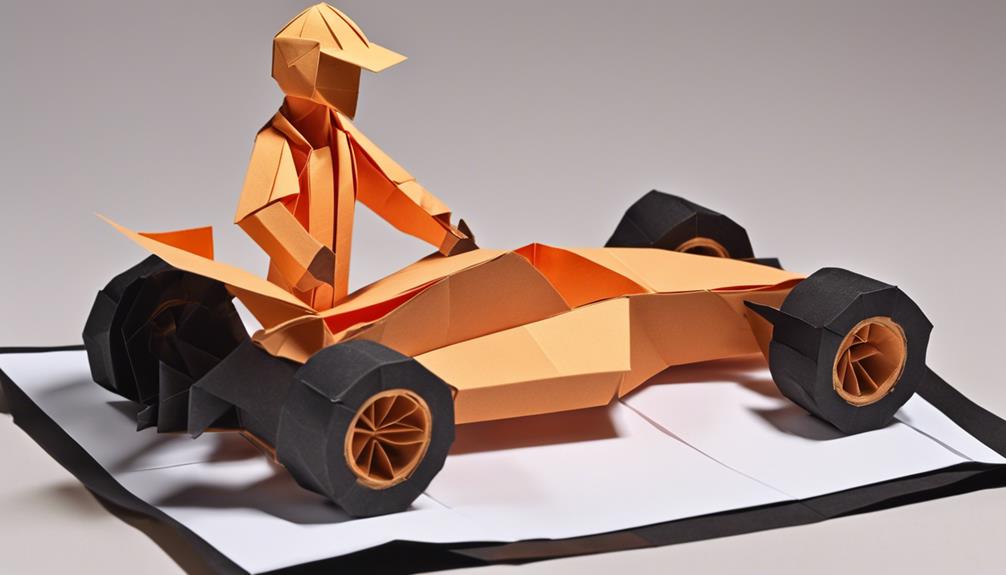General Rules of Sprint Car Racing
As a sprint car racer, you know that navigating the rules of the track is like steering through a complex labyrinth of regulations and guidelines. From the moment you hit the gas pedal to the final lap, every move you make is governed by a set of strict protocols designed to ensure fair competition and safety for all drivers involved. Understanding these rules could be the key to unlocking your full potential on the track and avoiding penalties that could cost you the race.
Vehicle Safety Regulations

When preparing for sprint car racing, it is crucial to adhere to strict vehicle safety regulations to ensure the well-being of drivers and spectators. Track preparation plays a vital role in maintaining safety standards. Proper track maintenance, including regular inspections for debris and ensuring adequate barriers, is essential to prevent accidents and injuries during races.
In terms of vehicle technology and innovation, sprint car racing has seen significant advancements in safety features. Roll cages, designed to protect drivers in the event of a rollover, have become standard in sprint car design. Additionally, advancements in seat technology, such as high-quality harness systems and impact-absorbing materials, have greatly improved driver safety.
When it comes to sprint car racing, safety should always be the top priority. Innovations in vehicle design and technology continue to push the boundaries of safety standards in the sport. By adhering to strict vehicle safety regulations and staying up to date with the latest safety innovations, drivers can minimize risks and ensure a safer racing environment for everyone involved. Remember, safety is paramount in sprint car racing, and following the regulations is crucial to prevent accidents and protect lives.
Driver Equipment Requirements
Ensuring compliance with specific driver equipment requirements is essential for maintaining safety standards in sprint car racing. When it comes to driver equipment, there are key regulations in place to protect drivers during high-speed races. Here are some important aspects to consider:
- Helmet Requirements: A proper helmet is crucial in sprint car racing. Helmets must meet strict safety standards and be approved by relevant authorities. They should fit securely on the driver's head to provide maximum protection in case of accidents.
- Suit Specifications: Drivers must wear fire-resistant suits that meet specified safety standards. These suits are designed to protect the driver from intense heat and flames that may occur in the event of a fire. It is essential that these suits fit properly to ensure full coverage and protection.
- Gloves and Shoes: In addition to the suit and helmet, drivers are required to wear fire-resistant gloves and shoes. These items are vital in protecting the hands and feet of drivers, reducing the risk of injury in case of a fire-related incident.
- Head and Neck Restraints: Head and neck restraints are mandatory in sprint car racing to prevent whiplash and neck injuries in the event of a crash. These restraints help stabilize the head and neck, reducing the risk of serious harm.
Race Procedures and Formats

When it comes to race procedures and formats in sprint car racing, understanding the points system is crucial. Points are awarded based on performance in various segments of the race, including the race starting process, heat race formats, and feature race structure. Familiarizing yourself with how points are allocated can give you a strategic advantage on the track.
Race Starting Process
To initiate a Sprint Car race, the race starting process follows specific procedures and formats designed to ensure fair competition and safety for all drivers involved. When it comes to the race starting process, there are several key elements to consider:
- Starting Positions: Drivers line up based on qualifying times or heat race finishes.
- Technique: Drivers must maintain proper spacing and speed during the formation lap.
- Yellow Flag: If an incident occurs before the race starts, the yellow flag may be displayed.
- Restarts: In case of a false start or caution during the initial start, a restart may be required to ensure fairness.
These aspects are crucial in setting the stage for an exciting and safe Sprint Car race.
Heat Race Formats
Heat race formats in Sprint Car racing dictate the structure and order in which drivers compete to secure their positions for the main event. Understanding the heat race format is crucial as it sets the stage for the rest of the racing night. Race strategy plays a significant role in heat races, with drivers needing to adapt quickly to changing track conditions. Driver skill and car setup are paramount in these shorter races, where every move counts towards securing a favorable starting position for the main event. It's essential to analyze the competition during the heat races, identifying strengths and weaknesses that can be exploited later. Paying attention to details during these preliminary races can give you a competitive edge when it matters the most.
Feature Race Structure
Understanding the feature race structure in Sprint Car racing is crucial for drivers aiming to navigate the race procedures and formats effectively. When it comes to the feature race, having a solid strategy is key to success. Here are some important points to consider:
- Feature Race Strategy: Develop a strategy that adapts to changing track conditions to maintain optimal performance.
- Pit Crew Communication: Efficient communication with your pit crew is essential for making timely adjustments during pit stops.
- Driver Feedback: Providing clear and concise feedback to your team about the car's handling can help them make necessary adjustments.
- Adapting to Conditions: Being able to quickly adapt to varying track conditions can give you a competitive edge over other drivers.
Track Etiquette and Safety

When racing sprint cars, understanding track etiquette and safety is crucial. You must prioritize safety gear, be aware of passing zones, and understand flag signaling to ensure a smooth and secure race. Safety gear importance, passing zone awareness, and flag signaling understanding are key components of track etiquette and safety in sprint car racing.
Safety Gear Importance
Prior to engaging in sprint car racing, it is essential to prioritize the correct safety gear to ensure protection on the track. When selecting safety gear, consider the following key factors:
- Helmet fit, comfort: Choose a helmet that fits snugly and comfortably on your head to provide maximum protection in case of impact.
- Glove material, grip: Opt for gloves made from durable materials that offer a good grip on the steering wheel, enhancing control and reducing the risk of slipping.
- Fire-resistant suits: Invest in fire-resistant suits to safeguard against potential fires in the event of a crash.
- Racing shoes: Select racing shoes with proper grip and ankle support to maintain stability while driving at high speeds.
Passing Zone Awareness
For optimal safety and efficiency on the track, maintaining awareness of the passing zone is crucial during sprint car racing. When approaching a passing opportunity, focus on corner entry to gain an advantage over your competitors. Understanding the drafting technique is essential for maximizing speed and overtaking opponents. By positioning your car strategically and utilizing the draft effectively, you can make decisive moves to pass others. Remember to be mindful of the passing zone's boundaries and respect fellow drivers to avoid collisions. Developing a keen sense of when and where to execute passes will elevate your racing performance and increase your chances of success on the track. Stay alert, anticipate opportunities, and navigate the passing zone with precision for a competitive edge.
Flag Signaling Understanding
Understanding flag signaling in sprint car racing is crucial for maintaining track etiquette and ensuring safety for all drivers. When on the track, pay close attention to flag communication to stay informed about track conditions and potential hazards. Here are some key points to consider:
- Safety precautions: Always be prepared to adjust your driving based on the flags displayed.
- Flag communication: Different flags indicate various situations such as yellow for caution and checkered for the end of the race.
- Stay alert: Keep your eyes up and scan for flags around the track constantly.
- Respect the flags: Adhere to the signals given by the track officials promptly and appropriately.
Pit Area Rules and Guidelines

When entering the pit area, adhere strictly to the designated speed limit to ensure the safety of all individuals present. Pit area decorum is crucial for maintaining a safe and organized environment during sprint car races. Observing safety precautions in the pit area not only protects you and others but also contributes to the overall efficiency of the racing event.
Maintaining a controlled speed while navigating the pit area is essential to prevent accidents and ensure the well-being of everyone in the vicinity. Pit crews, officials, and other racers are constantly moving about, making it imperative to be vigilant and cautious at all times. By following the speed limit, you exhibit respect for the rules and show consideration for the safety of those around you.
In addition to speed limits, respecting designated areas for specific activities in the pit area is essential. Different zones are allocated for tasks such as refueling, maintenance, and driver briefings. Adhering to these allocations helps streamline operations and prevents congestion, reducing the risk of accidents and improving overall efficiency.
Officiating and Penalties
In sprint car racing, officiating and penalties play a crucial role in maintaining fairness and enforcing rules on the track. When it comes to penalty enforcement, official authority is paramount. Officials are responsible for ensuring that all drivers adhere to the regulations set forth for a safe and fair race. Here are some key points to consider regarding officiating and penalties:
- Fair Judgment: Officiating in sprint car racing involves making split-second decisions that can greatly impact the outcome of a race. It is essential for officials to exercise fair judgment when determining penalties, taking into account the specific circumstances of each situation.
- Consistent Application: To maintain integrity within the sport, penalties must be enforced consistently. This means that similar infractions should result in similar consequences for all drivers, regardless of their reputation or standing in the racing community.
- Communication: Clear communication between officials and drivers is crucial when penalties are issued. Drivers need to understand the reasons behind the penalties imposed and how they can avoid similar infractions in the future.
- Appeal Process: In cases where drivers feel that a penalty was unjustly issued, there should be an appeal process in place. This allows for a fair review of the situation and ensures that all parties have the opportunity to present their side of the story.
Frequently Asked Questions
What Are Some Common Strategies for Passing Other Cars on the Track in Sprint Car Racing?
To pass cars in sprint car racing, focus on overtaking techniques like track positioning and drafting strategies. Plan corner entry carefully to outmaneuver opponents. These tactics can help you gain an advantage and make successful passes on the track.
How Do Weather Conditions Affect Sprint Car Racing and What Adjustments Need to Be Made to the Cars or Driving Techniques?
When racing in varied weather conditions, adjust tire pressure and suspension tuning to optimize performance. Rain delays impact track conditions, requiring drivers to adapt driving techniques. Stay alert to changes and make necessary adjustments for a competitive edge.
Are There Any Specific Training Exercises or Routines That Sprint Car Drivers Follow to Stay in Peak Physical Condition?
To maintain peak performance, sprint car drivers incorporate nutrition tips, training drills, injury prevention, and mental focus into their routines. Rigorous workouts, balanced diets, and mindfulness practices are vital for staying competitive.
What Are Some Typical Maintenance Practices That Teams Perform on Their Sprint Cars Between Races?
When prepping sprint cars between races, remember to check tire pressure and chassis setup for optimal performance. Don't forget engine maintenance and suspension tuning to keep your vehicle running smoothly and handling like a dream.
How Do Sprint Car Drivers Communicate With Their Pit Crews During a Race and What Information Is Typically Exchanged?
Like a symphony conductor directing musicians, you orchestrate pit crew dynamics during a race. Efficient communication is key, exchanging data on race strategies and passing techniques. Your seamless coordination ensures a synchronized performance on the track.






